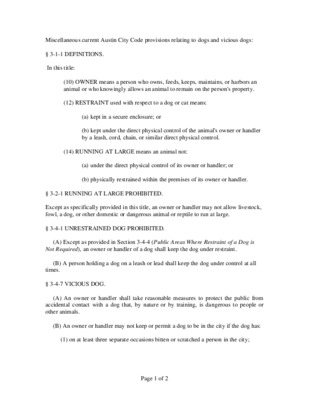Item 2b Miscellaneous — original pdf
Backup

Miscellaneous current Austin City Code provisions relating to dogs and vicious dogs: § 3-1-1 DEFINITIONS. In this title: (10) OWNER means a person who owns, feeds, keeps, maintains, or harbors an animal or who knowingly allows an animal to remain on the person's property. (12) RESTRAINT used with respect to a dog or cat means: (a) kept in a secure enclosure; or (b) kept under the direct physical control of the animal's owner or handler by a leash, cord, chain, or similar direct physical control. (14) RUNNING AT LARGE means an animal not: (a) under the direct physical control of its owner or handler; or (b) physically restrained within the premises of its owner or handler. § 3-2-1 RUNNING AT LARGE PROHIBITED. Except as specifically provided in this title, an owner or handler may not allow livestock, fowl, a dog, or other domestic or dangerous animal or reptile to run at large. § 3-4-1 UNRESTRAINED DOG PROHIBITED. (A) Except as provided in Section 3-4-4 (Public Areas Where Restraint of a Dog is Not Required), an owner or handler of a dog shall keep the dog under restraint. (B) A person holding a dog on a leash or lead shall keep the dog under control at all times. § 3-4-7 VICIOUS DOG. (A) An owner or handler shall take reasonable measures to protect the public from accidental contact with a dog that, by nature or by training, is dangerous to people or other animals. (B) An owner or handler may not keep or permit a dog to be in the city if the dog has: (1) on at least three separate occasions bitten or scratched a person in the city; Page 1 of 2 (2) on at least one occasion bitten or scratched a person to an extent that the attending physician has presented an affidavit to the health authority stating that the person’s life may have been endangered by the dog; or (3) on at least one occasion: (a) killed another dog, cat, or other domestic pet, fowl, or livestock; or (b) seriously injured another animal to an extent that an attending veterinarian has presented an affidavit to the health authority stating that the injured animal's life was seriously endangered or taken by the dog, or that the dog caused a significant permanent impairment of the injured animal’s basic bodily functions or mobility; provided, however, that when the incident occurred, the injured animal was not in violation of a provision of this title (Title 3) relating to the confinement or physical control of animals in the City. Page 2 of 2